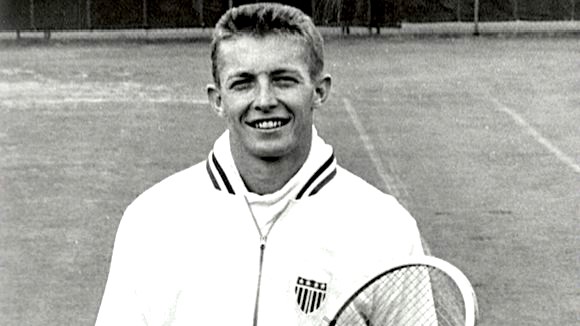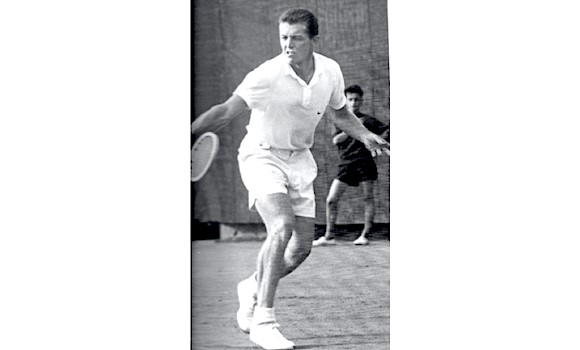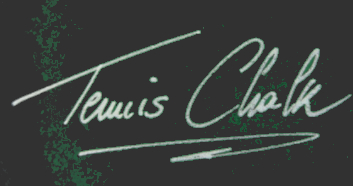Tony Trabert – Memories of My Friend – The beginnings
As the great Tony Trabert passed away on the last february, Tennis Chalk has the absolute honor to publish his long story, written by Mark Winters, who was probably in life one of the best friends of Tony. In order to keep content readable, enjoyable, and time affordable, Tennis Chalk has split the long article into episodes. This first one is dedicated to the beginnings of Tony’s tennis career until 1951.

In 50 years as a tennis journalist, this has been one of the most difficult stories I have ever attempted to write. The reasons are fairly simple. I had to sort through a wide collection of memories going back many years, along with many accompanying emotions.
When I learned that Tony Trabert had passed away at his home in Ponte Vedra, Florida on February 3rd this year, I realized the curtain had closed for the final time with my “Big Three”. They were the most significant people I spent time with during my tennis career. Tennis legend Jack Kramer was the first to depart on September 12, 2009. The Honorable Robert Kelleher, the eternal advocate for Open Tennis, was called away on June 20, 2012. During the first week of this year’s second month, Trabert, at the age of 90, made it a trio.
The group had a brotherly relationship. I became part of the family via good fortune that may have begun, quite simply, as blind luck. I first met Kramer in the 1960s. That led to an introduction to Trabert. I met Kelleher when the US played Mexico in 1963 in a spring Davis Cup tie at the Los Angeles Tennis Club. He was captain of the team and the US won the revered trophy that year. Because of his relationship with Kramer and Trabert, he became a member of a unique group of tennis leaders that, over time, became my cherished friends.
(Some readers may be aware of the career details that follow, but my heart tells me I must include them to sort through the myriad of Trabert recollections, even if they are merely satisfying my own need for continuity.)
Marion Anthony Trabert, the youngest of three sons, was born in Cincinnati, Ohio on August 16, 1930, to Arch and Bea Trabert. The family lived in a home in the Bond Hill section of the city that was a short distance from a park that sported four clay tennis courts. Tony’s brothers, Marc and Douglas, played on the courts there. He tagged along and started playing when he was six.
(In his youth, he was a fan of the local baseball team the Cincinnati Reds. He thought about pursuing a baseball career because he believed he was better in the sport. But tennis, because of the chess-like quality of the competition, proved to be more appealing.)
Records show that local teaching professionals, Earl Bossang and Howard Zaeh, provided the direction that led to Trabert’s solid stroke development. In 1942, at the Tri-State Tennis Championships, the 12-year-old began what would become a life-long friendship with Bill Talbert, who was also from Cincinnati. At that time, Talbert was ranked in the US Top 10, a position he would maintain for 13 straight years. Later that same year (1942), Talbert would team with Gardnar Mulloy to win the first of four US National Doubles Championships at Forest Hills, New York.
Talbert and Mulloy, who are both members of the International Tennis Hall of Fame in Newport, Rhode Island, are often included when talk turns to the game’s best doubles tandems. Because of his skill as a volleyer, Talbert helped Trabert improve his net play. It has been said that he felt Trabert was his “tennis doppelganger”, meaning that he was a youngster who was devoted to working hard to become a better player. (Trabert was dedicated to improving and becoming a better athlete. He attended Walnut Hills High School in Cincinnati and played on the basketball team because he believed it would make him more fit and quicker. His commitment led to his winning the Ohio interscholastic singles title three consecutive years.)
Fast forward eight years to 1950. Talbert was the No. 3 player in the US. Trabert, whose game was progressing was No. 12 in the rankings (and, interestingly, he would become No. 3 in 1951). Talbert told the United States Lawn Tennis Association, (the precursor of the USTA), that he and his wife, Nancy, were going to Europe to play the 1950 spring tournaments and he wanted Trabert to accompany them. He went further and asked for “travel expenses” pointing out that Trabert, a sophomore at the University of Cincinnati, in his eyes, was a future star and he wanted Trabert to be his doubles partner. The USLTA turned down the “financial assistance” request. Nonetheless, Trabert traveled with the Talberts and benefitted immeasurably.
(It is hardly a surprise when a tennis association or a federation “misses” a player with potential. But to have been blatantly “off” in the case of an individual, who had the support of Talbert, one of the game’s best at the time and who would go on to have a Hall of Fame career lends credence to a comment made by Kelleher, “It has been true for many, many years that you can’t get to be President of the USTA if you have a track record anywhere else. I have used the harsh expression that the USTA has been dominated by shoe clerks”.)
Kelleher, USTA President in 1967-68, teamed with British tennis officials Herman David and Derek Hardwick to help bring about Open Tennis in the last year of his term. In real life, he wasn’t involved in the shoe business, he was a US District Court Judge, thus his nickname “The Judge”.
(Years later, when asked about the USLTA’s lack of belief in his potential Trabert paused a moment, then after flashing his magical “toothpaste” perfect smile, shrugged his shoulders in “Que Sera, Sera” fashion.)
They – Bill and Nancy, along with Tony – flew to Nice in April. Monte Carlo was the first tournament they played, and they won the doubles. They added to their trophy collections with doubles triumphs at Nice, Internazionali d’Italia, Paris City Championships, Roland Garros and Queen’s Club.
In those days, tournaments offered travel expenses, along with a daily per diem which meant their continued winning minimized their out of pocket expenses. (At Wimbledon, Talbert was loyal and played with his long-time partner Mulloy. They lost in the third round to the Australian duo Ken McGregor and Frank Sedgman 8-6, 8-6, 8-10, 10-8. Trabert teamed with Budge Patty, the American who ended up living in Switzerland and was the 1950 Roland Garros and Wimbledon singles winner. They defeated McGregor and Sedgman in the quarterfinals, 6-4, 31-29, 7-9, 6-2. Geoff Brown and Bill Sidwell, another Australian tandem, were 6-4, 6-4, 6-3 better than Patty and Trabert in the semifinals, and went on to win the doubles title.)
Gianni Clerici, also a member of the International Tennis Hall of Fame, competed during the time Trabert and Talbert were in Italy, France and Great Britain. Clerici was a top Italian junior and after his days on the circuit became an award-winning journalist, television tennis commentator and playwright.
He has written a library’s worth of books on a variety of topics, but his “The Ultimate Tennis Book” (500 Anni di Tennis), is matchless when it comes to detailing the history of the game and supporting the discussion are many rare photos. In the tome, he wrote, “…But when Talbert arrived in Europe with a new doubles partner and told us that he was the “Lord’s appointed one”. We had no trouble agreeing with him.

Clerici went on to say, “Tony Trabert was the most American-looking individual that one could possibly imagine: hair close cropped like that of a Marine, a handsome, open face sprinkled with freckles, two enormous shoulders and legs thick as pillars. The only hope that we smaller players had was that he might be slow, but once we saw him in action on the court, we gave up the illusion and began to admire the man’s great ability. Like his Australian adversaries, Tony seemed to never get off the courts. One evening after three matches, I saw him politely ask a flabbergasted manager for some new balls in order to review a technical problem once more with Talbert.”
Prior to leaving on his three-month European excursion, Trabert had asked his parents, along with the president of the University of Cincinnati for advice about taking the trip. The educator told the sophomore that he would learn more abroad than he would in school. Upon his return, Trabert admitted that the jaunt was positively eye opening and helped him realize what it took to become an international standout.
Returning to the university in the fall, he juggled his tennis with his schoolwork. He majored in political science. He was also a starting guard on the Cincinnati basketball team. (He was a “playmaker”, not a scorer and good on defense. For him, the highlight of playing basketball was being a member of the team.)
The 1951 squad played in the National Invitation Tournament, (which, in those days, was more highly regarded than the NCAA Championship). On the tennis court in the spring, he won the NCAA singles, was a doubles finalist along with Bob Molt and led the school to second place in the Team Championship. (The University of Southern California finished with nine points to Cincinnati’s seven points.)

He won the 1951 National Clay Court Championships, 6-8, 2-6, 6-4, 6-3, 8-6, defeating Art Larsen. He teamed with Ham Richardson for the doubles title at tournament that was staged in River Forest, Illinois. He was also named to the Davis Cup team for the first time. July 9, 1951, was even more monumental.
In the Tri-State Tennis Tournament (now the Western & Southern Open) final he defeated his mentor Talbert for the first time. The score was 5-7, 4-6, 6-4, 6-3, 6-4. Later that afternoon, the Cincinnati duo disposed of Grant Golden and Hugh Stewart, 6-4, 6-1 in the doubles final.
